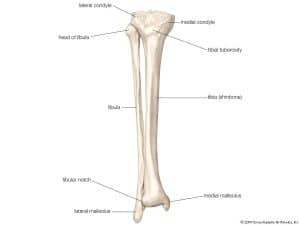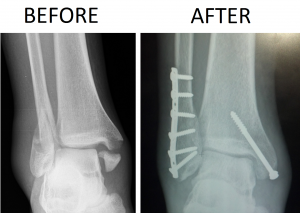
Bimalleolar and Trimalleolar Ankle Fracture Injury Lawyer
What are Bimalleolar and Trimalleolar Fractures?
Whether an ankle injury occurs due to a bad fall at work or in a major traffic accident, the damage done from a broken ankle can take many weeks or months to fully heal. Motorcycle riders and sports enthusiasts can also suffer serious harm to their ankle bones. In some very difficult cases, surgeons must perform repeat operations to correct any malunion (improper healing) and to further stabilize the ankle joint.
An experienced personal injury lawyer who offers a free consultation can help coordinate best in class medical care to speed recovery and obtain full compensation.
Bimalleolar fractures and Trimalleolar fractures occur after a wide range of personal injury accidents including slip and falls, trip and falls, motorcycle accidents, car accidents, and many others.
A better understanding of both bimalleolar and trimalleolar ankle fractures can be gained by noting the specific bones damaged in these injuries. Additional information below looks at the major risk factors for these types of ankle injuries, how they are often treated, and common complications that can occur after surgery.
Several key bones are involved in both bimalleolar and trimalleolar ankle injuries: the tibia and fibula.
The two bones usually involved in ankle fractures are the tibia and fibula.

At the end of the tibia bone is the medial malleolus, and at the end of the fibula is the lateral malleolus. These bones have been described as the larger “bumps” we can feel on both sides of our ankles. Although other bones nearby can be injured in various ways, most ankle fractures involve the ends of the fibula and tibia bones.

Complex ankle fractures, including both bimalleolar and trimalleolar fractures, are often very unstable. Some fractures can be displaced meaning there is a gap between the broken bones. A bimalleolar ankle fracture usually involves injuries to the lateral malleolus and the medial malleolus. Surgery is often required to not only repair fractured bones but to also stabilize the ankle joint and decrease the chances of arthritis developing later in life. Another similar injury is known as a bimalleolar equivalent fracture. This generally involves both a fracture of the lateral malleolus and an injury to a ligament on the inner side of the ankle – often called the deltoid ligament.
A trimalleolar ankle fracture involves the posterior malleolus, as well as the medial malleolus and the lateral malleolus. The posterior malleolus is the back part of the tibia bone. During ORIF (open reduction and internal fixation) surgery, the doctor attempts to put all the broken or fractured bones back together in the proper position — often using plates, screws, and sutures. It is open reduction because the doctor has to open up the injury and reduce the fracture often using internal fixation hardware. In some cases, rods are also used to help stabilize the ankle joint.
Proper diagnosis of ankle injuries
While basic X-rays are often sufficient, some ankle injuries are best diagnosed using a CT scan or an MRI. An orthopedic surgeon can review all these imaging tests while deciding upon the best possible treatment. Early intervention is always best to help quickly heal the ankle joint for long-term use. Great care must be taken to properly align every aspect of the ankle joint during surgery since even being just two millimeters off in resetting bones can later cause arthritis. Contacting an experienced law firm and experienced personal injury attorney can help the ultimate settlement value. The insurance company defending this case wants to save its money and pay as little as possible.
Common complications that can occur after ankle surgery for bimalleolar fractures or trimalleolar fractures include:
- Ongoing or increased pain
- Bleeding
- Unexpected injuries to nerves, tendons, or blood vessels
- Formation of blood clots
- Both mild and more serious infections
- Early signs of arthritis in the ankle
- Pain directly caused by the different plates and screws used to try to stabilize the ankle joint
- Unexpected delays in the bones healing properly
- Remaining or new misalignment of the ankle bones
- loss of proper alignment
- Ankle Arthritis
Follow-up surgeries are common once the different ankle joints have had time to achieve at least minimal healing.
Less troublesome ankle injuries can heal without surgery
Fortunately, many people who suffer ankle injuries can be fully treated by going through some physical therapy and wearing a large boot to stabilize the ankle joint. Many of these individuals are also advised to keep weight off their injured ankle by using crutches.
Individuals at greatest risk of incurring serious ankle injuries
- Workers who are required to handle their duties high off the ground, making them more likely to fall great distances
- Seniors or other older Americans who may already be starting to experience some degree of osteoporosis
- Everyone who rides in any type of motor vehicle
- Motorcyclists
- Those who take part in different sports, especially skiing and skateboarding
- Anyone who must walk on ice-covered streets or sidewalks
What should patients expect regarding surgery recovery time?
So much will depend on the extent of the fractures, the overall skills of the surgeon, and the quality and duration of the recommended physical therapy or rehabilitation program. Patient compliance with doctor recommendations is always crucial.
During the first two weeks after surgery, patients are usually provided with adequate pain medications and their ankle joints are kept in splints. After roughly 10 days to two weeks, the surgeon will remove the sutures and advise the patient to wear a removable boot.
In general, most patients are advised to wait 4 to 6 weeks after surgery to bear any significant weight on their injured ankles. Bones need plenty of time to heal without excess weight being placed on them too soon.
About six weeks after surgery, new x-rays are completed. If the bones are healing well, patients can start placing some weight on them and begin their physical therapy — which often lasts about six weeks.
Bimalleolar and Trimalleolar Ankle Fracture FAQs
How Much is a Bimalleolar Fracture or Trimalleolar Fracture With Surgery Worth?
Looking at a jury verdict search in New York, the full value of damages for a bimalleolar fracture with open reduction internal fixation (ORIF) surgical repair is probably from $200,000 to $500,000 or more. The ultimate recovery would change based on liability in the case, venue, and other factors. Trimalleolar fractures would command a value of $350,000 or more in personal injury claims. The fracture can also be transverse, angulated, displaced, or comminuted which would increase the ultimate value. An ankle fusion surgical procedure can be worth even more. Often we see this type of injury together with other injuries which would increase the damages amount.
What Types of Accidents Cause a Bimalleolar Ankle Fracture?
Severe Ankle fractures are usually caused by: Rolling, Twisting, or Sudden Rotating of the ankle. It can happen after many types of accidents including bicycle accidents, motorcycle accidents, pedestrian knockdown accidents, slip and falls, trip and falls, car accidents, and many others.
Why are Trimalleolar Fractures or Bimalleolar Fractures bad injuries?
This type of fractured ankle injury is often debilitating because the inner and outer parts of the ankle are both fractured in a medically delicate area where the tibia and fibula meet near the ankle.

This is why surgery in the form of open reduction internal fixation is very often needed for this type of broken ankle. Open reduction and internal fixation refer to using screws and metal plates to stabilize the fracture. The ankle is weight-bearing so daily activities are severely limited. Surrounding areas including the talus, heel bone, and ligaments are also affected and range of motion is limited. When the injury does not improve on its own, surgical treatment is needed.
How to Determine the Value of Bimalleolar or Trimalleolar Ankle Fractures?
How much is my injury case worth is a very common client question. Value ultimately depends on each particular case, the person bringing the case, the extent of the damages, and other factors. In New York, the courts rely on past cases and a jury verdict reporter publishes past settlements and verdicts. Some companies like Thompson Reuters even publish a book called Damages every year where someone can research a specific injury and see case values sustained by the Appellate Divisions for those injuries. A broken ankle that heals without residuals could be worth under six figures whereas a bimalleolar or trimalleolar ankle fracture with surgery should command well into the low to mid-six figures from $250,000 – $500,000 to well over $100,000. Elements of recovery include pain and suffering, mental anguish, loss of enjoyment of life, lost wages, and other damages.
If you have suffered a severe broken ankle injury caused by someone else’s negligence, please need to contact our New York City bimalleolar and trimalleolar fracture lawyers for a free consultation. We will carefully investigate all the facts of your case, review all your medical records, and then fight hard to win the maximum compensation for pain and suffering as well as other damages available for you. Our passion is helping serious injury victims and families obtain full settlement value or maximum jury verdict after a trial. We want every client to fully recover for all lost wages, pain and suffering, medical expenses, and other losses.
Fill out the form below & we will contact you as soon as possible.
We can tell you if you have a case or not within five minutes, Call (866) 288-9529
FREE CONSULTATION · NO FEE PROMISE · OVER $900 MILLION RECOVERED


